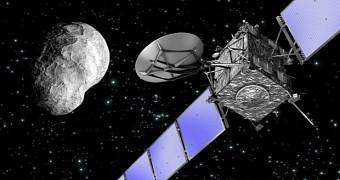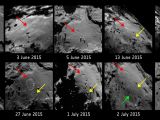A few weeks ago, in mid-August, Comet 67P/Churyumov-Gerasimenko came as close as 186 million kilometers (115 million miles) to the Sun, an event known to astronomers as perihelion.
The closer it got to the star, the more the comet would warm. In turn, this translated into increased activity on its surface. The orb started spewing out jets quite often and its appearance began to change ever so slightly.
The Rosetta probe got to witness the comet morphing
The European Space Agency's Rosetta probe was launched in March 2004. It reached Comet 67P/Churyumov-Gerasimenko back in last year's August and has been orbiting it ever since.
The spacecraft accompanied the orb on its journey towards the Sun and so got to observe it change in the months leading up to its close encounter with the star.
A set of images released earlier this week and obtained by the Rosetta probe between late May and mid-July show round features forming on the surface of Comet 67P/Churyumov-Gerasimenko.
The features came into being in the comet's Imhotep region, described by astronomers as comprising smooth terrains covered in a layer of fine-grained material and sprinkled with boulders.
“We had been closely monitoring the Imhotep region since August 2014, and as late as May 2015, we had detected no changes down to scales of a tenth of a meter.”
“Then one morning we noticed that something new had happened: the surface of Imhotep had started to change dramatically. The changes kept going on for quite a while,” said researcher Olivier Groussin in a statement, as cited by Phys Org.
In early July, two newly formed round features on Comet 67P/Churyumov-Gerasimenko measured around 220 meters (720 feet) and 140 meters (460 feet) across, respectively. Yet another was forming in their proximity.
Then, these three features merged to form a single one and two more came into being nearby. Scientists expect that, in the months to come, the comet will continue to change.
A possible explanation for these appearances
Sublimation, which is the transition of a substance directly from its solid to its gas phase, best explains the formation of these round features on Comet 67P/Churyumov-Gerasimenko.
As the orb got closer and closer to the Sun and grew warmer, exposed ices on its surface experienced such transitions. In a nutshell, the comet began to disintegrate.
Nonetheless, researchers say the features are growing too fast for sublimation alone to explain their formation and evolution. Rather, odds are that other processes are also at play.
One possibility is that the ices that sublimated were especially weak and so vanished faster than expected. Mission scientists over at the European Space Agency hope that, when Rosetta delivers more data, they'll sort out this mystery.

 14 DAY TRIAL //
14 DAY TRIAL // 



